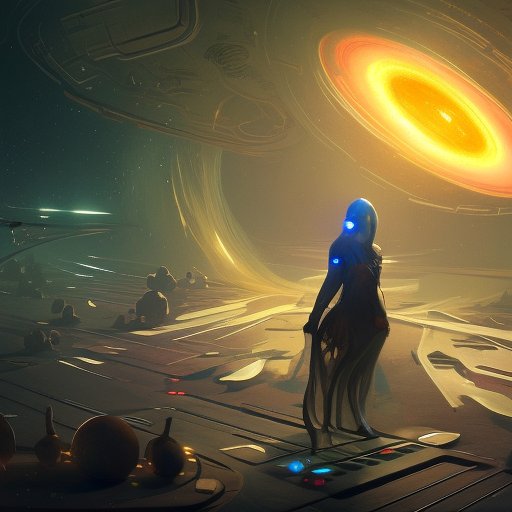
The concept of artificial gravity has been a staple of science fiction for decades, from Frank Herbert’s Dune series to Star Trek and beyond. But what if we could generate gravity in space for real? In this article, we explore the science behind artificial gravity, the potential benefits and drawbacks of this technology, and its connection to science fiction. While we’re not quite at the point where we can create gravity on demand using Holtzman generators or any other similar technology, the idea of generating gravity on a spacecraft has been studied and experimented with for decades. The potential benefits of artificial gravity are numerous, from mitigating the health risks associated with zero gravity environments to making space travel more comfortable and practical for astronauts. At the same time, there are also significant challenges and drawbacks to consider, including technical complexity, health risks, space limitations, cost, and compatibility with current space technology. Despite these challenges, the concept of artificial gravity remains an exciting area of research and development, and the connection to science fiction is a reminder of how this genre can inspire and inform real-world technological developments. In the end, the concept of artificial gravity in space is a fascinating and complex one that will continue to capture the imaginations of scientists, engineers, and science fiction fans alike.
I. Introduction

Space exploration has captured our imaginations for decades, from the earliest science fiction stories to the real-life moon landings and beyond. But despite all the progress we’ve made in exploring the cosmos, one thing still eludes us: gravity. Or rather, the lack of it. For astronauts in space, zero-gravity environments can lead to a host of health issues, from bone loss to muscle atrophy to disrupted sleep patterns. But what if we could create artificial gravity in space? What if we could simulate the familiar pull of Earth’s gravity on a spacecraft hurtling through the void? It’s an exciting concept that has been explored in science fiction for years, from classic shows like Star Trek to epic novels like Dune. And while we’re not quite there yet in terms of real-world technology, the idea of artificial gravity is one that continues to capture our imagination and inspire us to reach for the stars. In this article, we’ll explore the science behind artificial gravity, its potential benefits and drawbacks, and its connection to classic science fiction like Dune.
II. The science behind artificial gravity
Artificial gravity may sound like the stuff of science fiction, but the concept is based on some pretty solid scientific principles. At its core, artificial gravity relies on the same physical force that keeps us all anchored to the ground: gravity itself.

In space, there’s no gravity to speak of – at least, not in the way we’re used to. Objects in orbit around the Earth experience a state of freefall, where they’re essentially falling towards the planet but never quite get there. This creates a sensation of weightlessness, or zero gravity, that can be disorienting and even harmful to human health over long periods of time.
To create artificial gravity in space, we need to simulate the pull of Earth’s gravity on a spacecraft. The most common way to do this is through the use of centrifugal force. Imagine a spinning top: as it spins faster and faster, the force pushing outwards from its center becomes stronger and stronger. This is the same principle that we can use to create artificial gravity on a rotating spacecraft.
By spinning a spacecraft at a constant rate, we can create a force that pushes objects towards the outer edge of the rotating structure. From the perspective of someone inside the spacecraft, this force would feel just like gravity. The amount of artificial gravity generated depends on a number of factors, including the size of the spacecraft, the rate of rotation, and the distance from the center of rotation.
Of course, creating artificial gravity in space is easier said than done. For one thing, it requires a lot of energy to keep a spacecraft spinning at a constant rate for long periods of time. There are also potential health risks associated with exposure to artificial gravity, including motion sickness and the potential for injury from sudden changes in gravity levels. Despite these challenges, the concept of artificial gravity remains an exciting and potentially game-changing development in the field of space exploration.
III. The benefits of artificial gravity
The idea of artificial gravity may seem like a luxury rather than a necessity, but there are actually some compelling reasons why we might want to create gravity on spacecraft. Here are just a few of the potential benefits:

- Improved health and comfort for astronauts: One of the biggest challenges of long-duration spaceflight is the toll that zero gravity can take on the human body. Astronauts who spend extended periods of time in space can experience bone loss, muscle atrophy, and weakened immune systems. By creating artificial gravity on spacecraft, we could help mitigate these effects and make space travel more comfortable for astronauts.
- Easier and safer movement within spacecraft: Moving around in a zero-gravity environment can be a challenge, especially when it comes to basic tasks like eating, sleeping, and using the bathroom. By creating artificial gravity, we could make it easier for astronauts to move around and perform these tasks, reducing the risk of accidents and injuries.
- Better sleep quality: Without the natural cycle of day and night that we experience on Earth, astronauts can struggle with sleep issues like insomnia and circadian rhythm disruption. Creating artificial gravity could help recreate a more natural sleep environment, making it easier for astronauts to get the rest they need.
- Potential cost savings: Building and maintaining a rotating spacecraft capable of generating artificial gravity would no doubt be a complex and expensive undertaking. However, the potential health benefits of artificial gravity could ultimately outweigh these costs, especially when it comes to long-duration missions where astronaut health is a major concern.
These are just a few of the potential benefits of artificial gravity in space. Of course, there are also some potential drawbacks and challenges to consider, which we’ll explore in the next section. Nonetheless, the concept of creating gravity in space remains an intriguing and exciting one that could open up new possibilities for human space exploration.
IV. The Drawbacks of Artificial Gravity
While there are many potential benefits to creating artificial gravity in space, there are also some significant challenges and drawbacks to consider. Here are a few of the most important:

- Technical complexity: Creating artificial gravity on a spacecraft would require some pretty advanced engineering and technology. The spacecraft would need to be designed to rotate at a precise rate to generate the desired amount of artificial gravity, which would require a lot of energy and sophisticated control systems.
- Health risks: While artificial gravity could help mitigate some of the health risks associated with zero-gravity environments, there are also potential risks associated with exposure to artificial gravity. Rapid changes in gravity levels, for example, could cause motion sickness or other health issues.
- Space limitations: Creating a rotating spacecraft capable of generating artificial gravity would likely be a large and complex undertaking. It would require a lot of space, which could be a challenge in the cramped quarters of a spacecraft.
- Cost: Building and maintaining a rotating spacecraft would no doubt be expensive. It’s unclear whether the potential benefits of artificial gravity would outweigh these costs, especially for shorter missions where the health risks of zero gravity are less pronounced.
- Compatibility with current space technology: Many current spacecraft are not designed to accommodate the complexities of artificial gravity. Retrofitting existing spacecraft to generate artificial gravity could be a significant challenge.
Despite these challenges, the concept of artificial gravity in space remains an exciting and potentially transformative development. By addressing some of the health risks associated with zero gravity environments and making space travel more comfortable and practical for astronauts, artificial gravity could open up new possibilities for human space exploration. It will be fascinating to see how this technology develops in the years to come, and whether we’ll one day be able to create gravity on spacecraft as easily as we create it here on Earth.
V. The Dune Connection
If you’re a fan of science fiction, you may already be familiar with the concept of artificial gravity from books like Frank Herbert’s Dune series. In these books, artificial gravity is a common technology used to generate gravity on spaceships and other structures in space.

In the Dune universe, artificial gravity is generated using a technology called “Holtzman generators,” which create a gravitational field that can be adjusted to different levels of intensity. This technology plays a major role in the plot of the Dune books, as it allows characters to travel through space and inhabit artificial environments without the health risks associated with zero gravity.
Of course, the technology in Dune is purely fictional, and we’re not quite at the point where we can generate gravity in space using Holtzman generators or any other similar technology. However, the concept of artificial gravity in Dune is an interesting example of how science fiction can inspire and inform real-world technological developments.
In fact, the concept of artificial gravity has been a staple of science fiction for decades, appearing in books, movies, and TV shows from Star Trek to The Expanse. As our understanding of the physics of gravity and the challenges of space travel continue to evolve, it’s likely that the concept of artificial gravity will continue to inspire and inform future technological developments in space.
VI. Conclusion
In conclusion, the concept of artificial gravity in space is a fascinating and potentially transformative development. While we’re not quite at the point where we can create gravity on demand using Holtzman generators or any other similar technology, the idea of generating gravity on a spacecraft has been studied and experimented with for decades.
The potential benefits of artificial gravity are numerous, from mitigating the health risks associated with zero gravity environments to making space travel more comfortable and practical for astronauts. At the same time, there are also significant challenges and drawbacks to consider, including technical complexity, health risks, space limitations, cost, and compatibility with current space technology.

Despite these challenges, the concept of artificial gravity remains an exciting area of research and development. With the right technological advances and scientific breakthroughs, it’s possible that we could one day generate gravity on a spacecraft as easily as we do on Earth. This could open up new possibilities for human space exploration, from longer missions to more comfortable and practical living arrangements in space.
The connection to science fiction, particularly to Frank Herbert’s Dune series, is an interesting reminder of how science fiction can inspire and inform real-world technological developments. While the technology in Dune may be purely fictional, the concept of artificial gravity has been a staple of science fiction for decades, and it’s likely that this genre will continue to inspire and inform future technological developments in space.
In the end, the concept of artificial gravity in space is a fascinating and complex one that will continue to capture the imaginations of scientists, engineers, and science fiction fans alike. As we continue to explore the possibilities and challenges of generating gravity in space, we’ll undoubtedly learn more about the physics of gravity and the potential benefits and drawbacks of this technology. Whether we’ll one day create artificial gravity in space remains to be seen, but one thing is certain: the potential benefits are too great to ignore.






